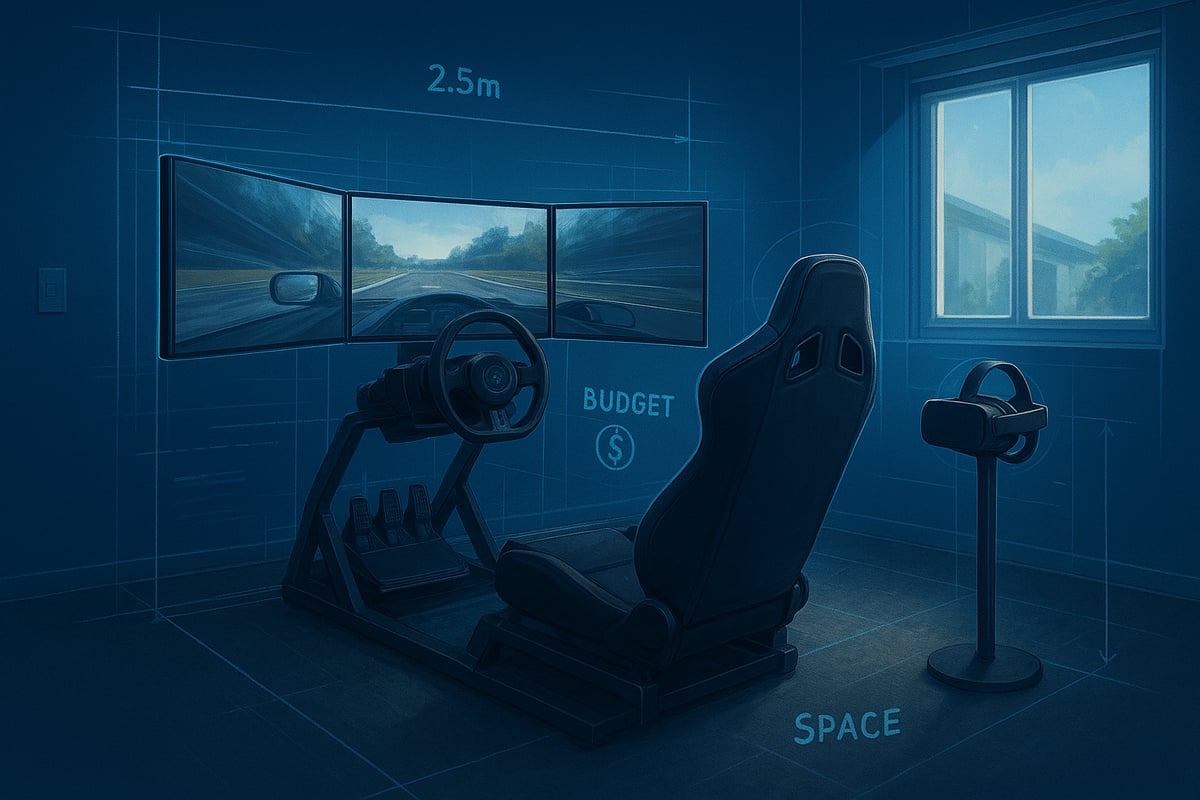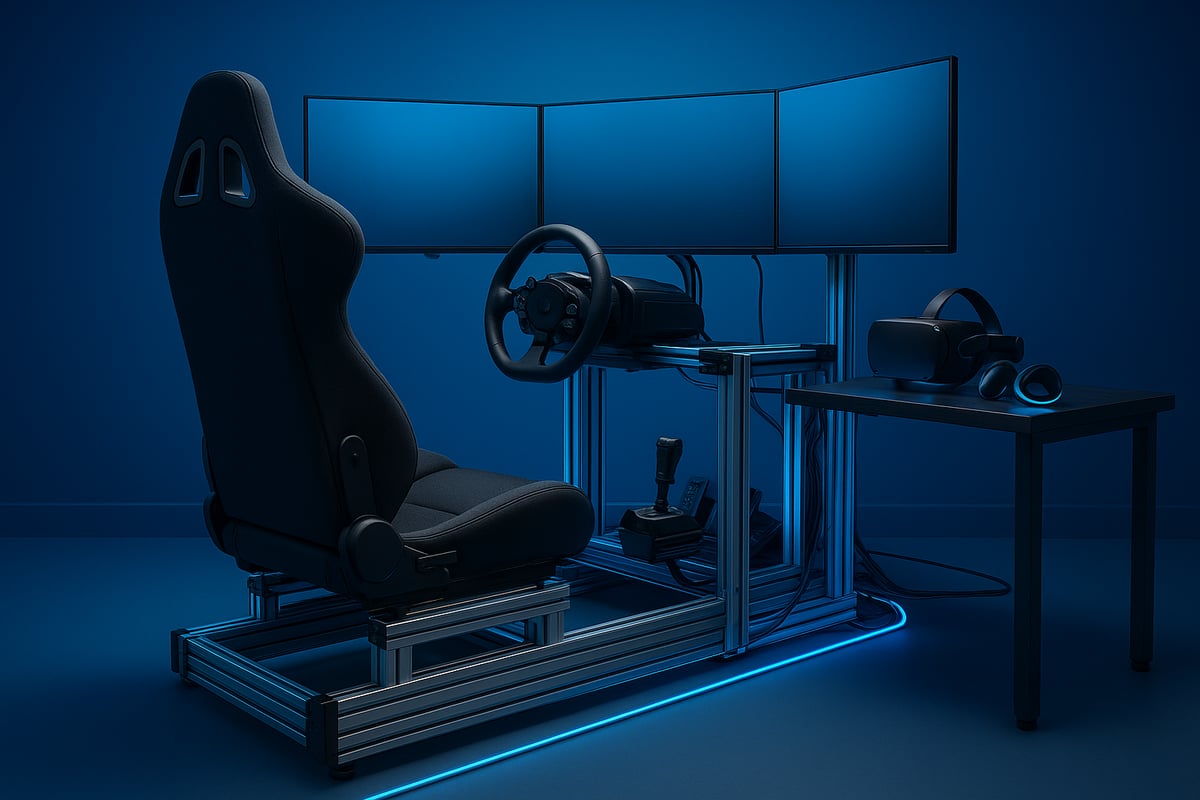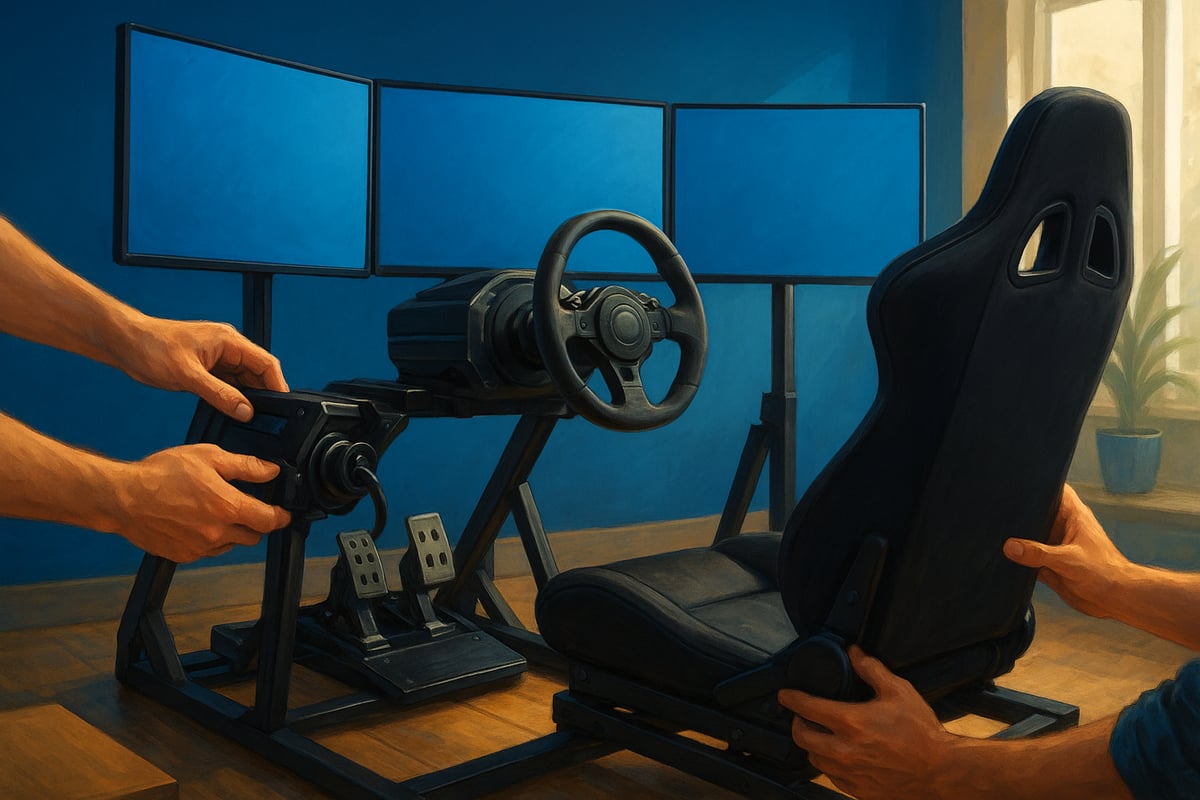
Full Racing Simulator Setup Guide: Build Your Dream Rig 2025
|
|
Imagine feeling the rush of high-speed racing, all from the comfort of your living room. As sim racing explodes in popularity across Australia, more people are chasing the dream of building the ultimate full racing simulator setup. Why is 2025 the perfect year? The technology is better than ever, and there are more options for every budget.
With the right gear, you can experience breathtaking realism, sharpen your driving skills, and maybe even get a competitive edge online. This guide is here to steer you through every step, from choosing the best hardware to assembling and optimising your rig. Ready to dive in? You’ll learn how to create a setup tailored to your needs, covering hardware, software, assembly, customisation, and troubleshooting tips.
Before you buy your first wheel or seat, planning is the secret sauce for a full racing simulator setup that truly fits your needs. Every great sim rig starts with a solid foundation, so let's break it down step by step.

First things first, measure your available space. Will your full racing simulator setup squeeze into a lounge room, or do you have a spare room to dedicate? Grab a tape measure and note dimensions, including space for the seat to slide back and for you to move freely.
Think about ventilation, especially if you're racing in summer, and make sure lighting won't create screen glare. Ergonomics matter too: you want a spot where you can sit comfortably for hours.
Budget is the next big consideration. Entry-level setups can start under $1,000, but a high-end build can easily surpass $5,000. Decide upfront what you're willing to spend, then balance performance against cost for each component. For example, a small apartment might suit a foldable rig, while a sim room opens doors to robust frames like the Trak Racer TR160 Racing Simulator.
What do you want from your full racing simulator setup? Are you chasing the thrill of F1, the challenge of GT, or the sideways fun of rally? Your favourite racing genre will shape your hardware and software choices.
If you love solo time trials, a simple wheel and pedal combo might do. But if you plan to compete online, you may want higher-end gear and a reliable PC. Some racers prioritise realism and immersion, others want comfort or the ability to pack up quickly.
Check out what the community recommends and read user reviews. Esports hopefuls often choose direct drive wheels and pro pedals, while casual racers may lean toward portability and easy storage.
Sim racing tech evolves fast, so it's smart to future-proof your full racing simulator setup. Consider trends like VR, triple-screen displays, and haptic feedback systems. Choose components that let you upgrade later, such as modular cockpits or adjustable monitor stands.
Compatibility is key. Make sure your setup will work with upcoming games and the latest peripherals. Modular designs can keep your rig fresh, and resale value matters if you plan to swap out parts. Did you know 68% of sim racers plan to upgrade their rigs in the next two years? Staying flexible will keep you ahead of the curve.
Now, make a personalised shopping list. Jot down every part you’ll need for your full racing simulator setup, from cockpit and seat to wheel, pedals, and display. Separate the essentials from the nice-to-haves, so you can budget and upgrade in stages.
A simple checklist might look like this:
| Essential Components | Optional Upgrades |
|---|---|
| Cockpit/Frame | Motion platform |
| Racing Seat | Bass shakers |
| Wheel & Pedals | Button box |
| Display (Monitor/VR) | Custom liveries/LEDs |
This prep work will set you up for a smooth build and an unbeatable racing experience.
Building your full racing simulator setup starts with picking the right hardware. The choices you make here will shape your experience every time you get behind the virtual wheel. Let’s break down the essentials so you can confidently create a setup that fits your goals, space, and budget.

The cockpit or frame is the backbone of your full racing simulator setup. You’ll find options like sturdy aluminium profiles, classic tubular steel frames, and clever foldable designs for tight spaces.
Aluminium profile rigs are popular for their adjustability and rock-solid stability, making them a favourite for direct drive wheel users. Tubular steel frames can be budget-friendly and durable, while foldable frames suit those who need to pack away their setup after each session.
When choosing, consider:
If you’re chasing the most authentic experience, a rigid cockpit is a must for a full racing simulator setup. For example, direct drive wheels demand a frame that won’t flex under pressure, so investing here pays off in realism and comfort.
A comfortable, supportive seat is essential for enjoying long sessions in your full racing simulator setup. You’ll typically choose between fixed bucket seats and adjustable gaming chairs. Bucket seats offer race car realism and keep you locked in place during intense races, while gaming chairs can be more adjustable and suitable for shared spaces.
Look for features like lumbar and neck support, breathable fabric, and sturdy mounts. Materials range from classic fabric to premium leather and even hybrid designs. Inspiration often comes from real-world motorsport seats, blending style with function.
If you want to avoid discomfort and fatigue, check out options that prioritise ergonomics. For an example of a seat designed for sim racing comfort and support, see the Choosing a racing seat guide. Investing in the right seat makes your full racing simulator setup feel just like the real thing.
No full racing simulator setup is complete without a quality wheel and pedal set. The main types of force feedback wheels are:
Pedal sets also make a big difference. Load cell brake pedals offer realistic pressure and better modulation, while potentiometer brakes are simpler but less precise. Make sure your chosen gear is compatible with your PC or console of choice, whether that’s Windows, PlayStation, or Xbox.
Compare popular models like the Logitech G923 (great for beginners) with the Fanatec CSL DD (ideal for more serious racers). Choosing the right wheel and pedal combo brings your full racing simulator setup to life, letting you feel every corner and braking zone.
How you see the track is just as important as how you drive. Your full racing simulator setup can use a single monitor, triple screens, an ultra-wide display, or a VR headset. Each has its pros and cons.
Triple monitors are a favourite for immersion, offering a wide field of view and real peripheral vision. According to SimTech Insights, 37% of sim racers use triple monitors for a more realistic experience. If you want buttery-smooth visuals, look for high refresh rates (120Hz or higher) and fast response times.
VR headsets are growing in popularity, delivering unrivalled immersion and head tracking. However, they need a powerful PC and may not be for everyone due to comfort or motion sickness. Whichever you choose, make sure it fits your space and enhances your full racing simulator setup.
When you’re building a full racing simulator setup, it’s the extra touches that transform a good rig into a truly immersive experience. Supporting accessories and thoughtful upgrades can make your sim racing feel more authentic and tailored to your driving style. Let’s explore the best add-ons to elevate your setup, from precision gear shifters to the right sound system.

A full racing simulator setup isn’t complete without tactile controls that mimic real racing. Sequential and H-pattern shifters let you choose between rally-style quick shifts or classic manual gear changes. For rally and drift fans, a dedicated handbrake adds precise control in tight slides. Customisable button boxes give you instant access to car settings, pit commands, and even headlights.
If you crave a premium feel, consider the VNM Shifter for sim racing, known for its realistic feedback and robust build. Many esports competitors rely on these advanced controls, especially when competing in rallycross championships or endurance events. Whether you’re mapping out a complex F1 steering wheel or adding extra toggles for GT racing, these upgrades put you in command.
Audio is a game changer for your full racing simulator setup. The right sound setup lets you hear every gear change, tyre squeal, and rumble strip, pulling you deeper into the action. Do you prefer the privacy and clarity of a quality headset, or the cinematic feel of surround sound speakers?
Some racers add vibration transducers, like Buttkickers, that let you feel engine revs or road textures through your seat. This tactile feedback boosts immersion, making every lap more exciting. Here’s a quick comparison:
| Audio Option | Pros | Cons |
|---|---|---|
| Headset | Isolated sound, clear chat | Less immersive |
| Surround Speakers | Room-filling, realistic | Needs space |
| Bass Shaker | Physical feedback | Extra setup needed |
Experiment with combinations to find what brings your races to life.
Your full racing simulator setup depends on solid hardware under the hood. For PC users, check minimum and recommended specs for 2025’s top titles. Focus on a strong graphics card, fast CPU, and at least 16GB RAM for smooth gameplay. SSD storage helps reduce load times, keeping you in the race.
Console racers aren’t left out—modern PlayStations and Xbox consoles support many top sim titles and peripherals. Cross-platform play is gaining traction, so you can compete with friends regardless of hardware. Did you know 54% of sim racers upgraded their PC recently? Staying current ensures your setup is future-ready and performs at its best.
A tidy workspace matters for every full racing simulator setup. Neat cable management prevents tripping hazards and keeps your rig looking sharp. Use Velcro straps, cable sleeves, or under-desk trays to guide wires out of sight.
Don’t overlook power. Surge protectors safeguard your investment from unexpected outages, and an uninterruptible power supply (UPS) can save your race if the lights flicker. Taking a few minutes to organise cables and protect your gear pays off with peace of mind and a clean, professional look.
You’ve gathered all your gear, and now comes the most exciting part—bringing your full racing simulator setup to life. Whether you’re unpacking your first wheel or building a pro-grade cockpit, careful assembly ensures everything feels just right when you hit the virtual track.

Start by unboxing and laying out all your components. Check your manuals and confirm that nothing’s missing. Assemble your cockpit or frame first, making sure it’s stable and secure. Attach your racing seat, ensuring it’s fixed at the right height and distance for your comfort.
Next, mount your wheelbase, pedals, and shifter according to the manufacturer’s instructions. If you’re using multiple monitors, a dedicated triple monitor stand for racing sims can make alignment and stability much easier. Secure your displays at eye level for optimal immersion. Set up your audio system—whether it’s a headset or surround speakers—so you’re fully enveloped in the race.
For a first-timer, expect setup to take around 2–3 hours. Experienced builders can get a full racing simulator setup running in under 90 minutes. Take your time to avoid mistakes that could affect performance or safety.
Once your hardware is assembled, it’s time to power up your full racing simulator setup and get your software dialled in. Start by installing the latest drivers and firmware updates for your wheel, pedals, and any other peripherals. This ensures compatibility and smooth performance.
Calibrate your wheel and pedals using the manufacturer’s tools or within your chosen racing sim. Adjust force feedback strength, steering rotation, and pedal sensitivity until everything feels natural. Set up dead zones to eliminate unwanted input drift.
Install your sim racing software—popular choices include iRacing, Assetto Corsa, and rFactor 2. Configure your in-game settings to match your hardware and display setup. Test each component to confirm everything responds as expected before jumping into your first race.
No matter how advanced your full racing simulator setup is, comfort is key for long stints behind the wheel. Adjust your seat so your legs are slightly bent and your feet rest naturally on the pedals. The steering wheel should be at chest height and close enough for a relaxed grip.
Keep your monitors at eye level and about an arm’s length away to minimise neck strain. Use seat cushions, wrist supports, or anti-fatigue mats for added comfort. Good lighting and ventilation help keep you alert and comfortable during marathon sessions.
Take regular breaks to stretch and hydrate. A well-set-up cockpit lets you focus on racing, not aches and pains.
Before you declare your full racing simulator setup ready for action, do a quick systems check. Test all buttons, shifters, and pedals for responsiveness. If you run into problems, check connections, review manuals, and look up solutions in sim racing communities or the manufacturer’s support page.
If you notice odd noises, calibration errors, or software glitches, don’t panic. Most issues are solved with a quick reset or firmware update. A little patience now means more uninterrupted racing later.
Your full racing simulator setup is more than a collection of parts, it is your personal racing hub. The right tweaks and ongoing care can transform your rig from a basic setup into a truly immersive experience. Let’s explore how you can personalise, upgrade, and maintain your simulator, while staying connected with the thriving Aussie sim racing community.
Customisation is where your full racing simulator setup truly becomes yours. Start with custom liveries and vinyl wraps to mirror your favourite F1 or V8 Supercars team, or add LED lighting for dramatic effects during night races. Many sim racers go further by installing motion platforms and tactile feedback systems, making every kerb strike and gear shift feel real.
Want an extra layer of immersion? Try a programmable button box, or integrate a dashboard display for live telemetry. For inspiration, check out sim racers who have built F1-inspired cockpits, complete with replica steering wheels and authentic seat positions.
With the right custom touches, your full racing simulator setup will feel like a genuine pit garage.
As your skills improve, you’ll notice when it’s time to upgrade your full racing simulator setup. Maybe your pedals start to feel too basic, or your wheel lacks the feedback of high-end direct drive units. Upgrading can be as simple as swapping in a new seat, or as advanced as installing a triple-screen display or motion platform.
Pay attention to performance bottlenecks, especially if you’re chasing faster lap times or a more realistic feel. According to Sim Racing Hardware Statistics 2024, most sim racers upgrade their hardware as new technology becomes available, keeping their rigs competitive and enjoyable.
Keeping your full racing simulator setup up to date keeps the racing experience fresh and exciting.
A well-maintained full racing simulator setup will last for years. Clean and lubricate moving parts like wheel bases and pedal pivots regularly. Use gentle cleaners for seats and upholstery, especially if you’ve chosen premium materials like leather or Alcantara.
Protect electronics from dust, spills, and power surges. When not in use, cover your rig or move it to a safe spot to prevent accidental damage. Schedule a quick monthly check to tighten bolts, inspect cables, and confirm everything works smoothly.
Routine care ensures your full racing simulator setup delivers top performance every session.
Joining the sim racing community adds a social and competitive edge to your full racing simulator setup journey. Australian sim racing leagues, forums, and Discord groups offer everything from tuning guides to live race broadcasts.
Get involved by sharing your setup, learning from others, and participating in local or online events. You’ll always find tips, troubleshooting help, and new friends who share your passion for virtual motorsport.